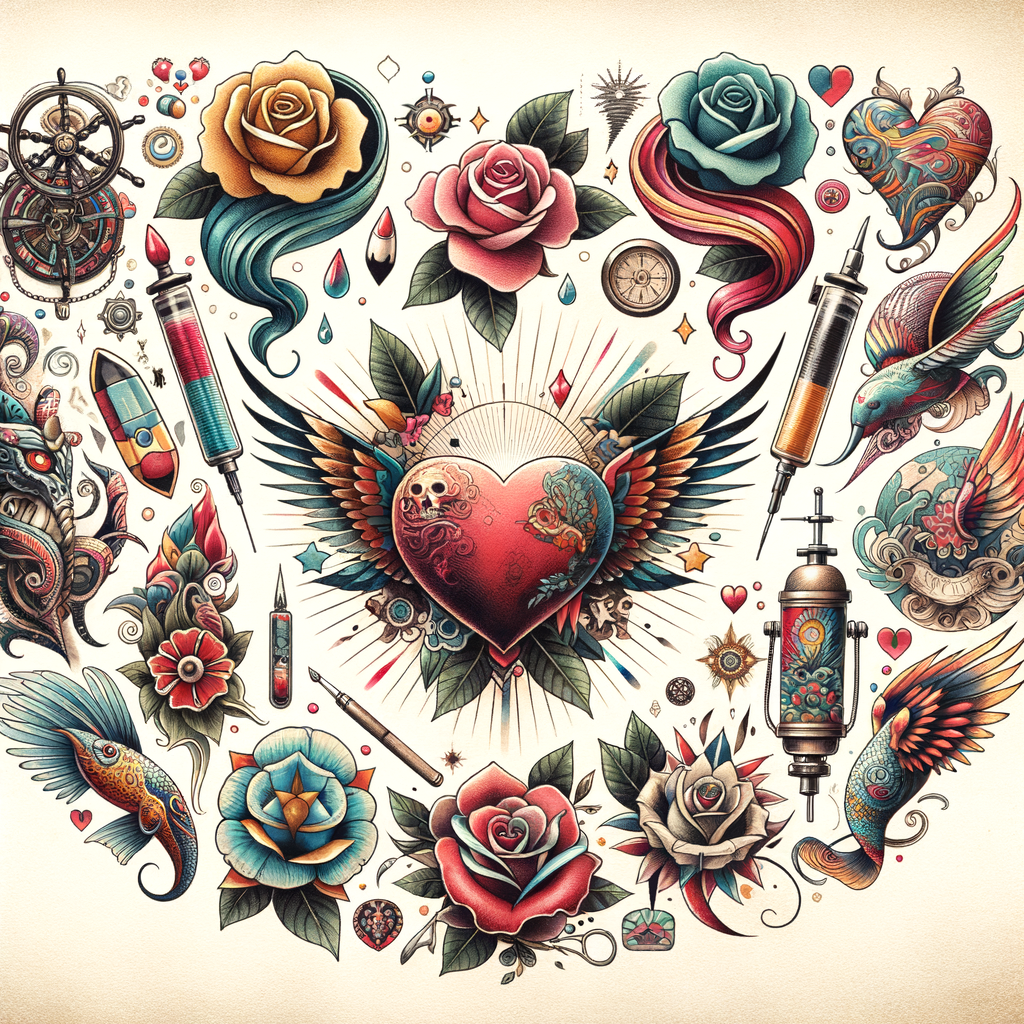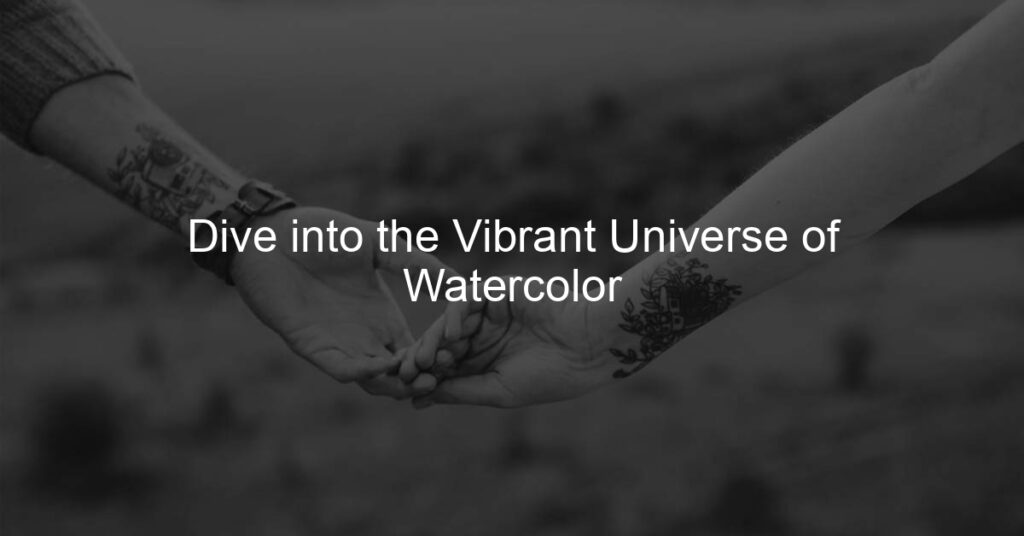
Introduction to Watercolor Tattoos
Watercolor tattoos have become a popular choice for those seeking a unique and vibrant form of body art. This blog post will provide a comprehensive introduction to watercolor tattoos, including their definition and the history of their evolution.
-
- Definition of Watercolor Tattoos
Watercolor tattoos are a style of tattooing that mimics the distinct aesthetics of watercolor paintings. They are characterized by their vibrant colors, soft edges, and the absence of black outlines that are typically found in traditional tattoo styles. The result is a tattoo that appears fluid, as if it were painted onto the skin with watercolors. This style of tattooing is often used to create abstract designs or to enhance the realism of a piece.
-
- History and Evolution of Watercolor Tattoos
The watercolor tattoo style is a relatively new development in the world of tattooing. It emerged in the late 20th century, as tattoo artists began to experiment with different techniques and styles. The first watercolor tattoos were simple and often incorporated traditional tattoo elements. However, as the style evolved, artists began to create more complex and abstract designs, pushing the boundaries of what was possible with tattoo ink.
Today, watercolor tattoos are recognized as a distinct style within the tattoo industry. They are celebrated for their artistic quality and the skill required to create them. Despite their relatively short history, watercolor tattoos have made a significant impact on the world of body art, and their popularity continues to grow.
Watercolor Tattoo Designs
Watercolor tattoos are a unique and vibrant choice for anyone seeking a distinct and eye-catching design. Let’s explore some of the most popular watercolor tattoo designs that are currently trending.
Popular Watercolor Tattoo Designs
There are countless watercolor tattoo designs to choose from, each with its own unique appeal. Here are three of the most popular categories:
-
- Floral Designs
Floral designs are a classic choice for tattoos, and they take on a whole new dimension when rendered in watercolor. The delicate petals and leaves can be filled with a wash of color that mimics the natural beauty of flowers. These designs can range from a single flower to a whole bouquet, and they can be customized with any colors you like.
-
- Abstract Designs
Abstract designs allow for a high degree of creativity and personal expression. They often incorporate a mix of shapes, lines, and colors to create a design that is open to interpretation. Abstract watercolor tattoos can be a great way to represent a concept or emotion in a visually striking way.
-
- Animal Designs
Animal designs are another popular choice for watercolor tattoos. Whether it’s a beloved pet, a favorite animal, or a symbol of your spirit animal, these designs can be incredibly meaningful. The watercolor technique allows for a realistic or whimsical representation, depending on your preference.
Remember, the best tattoo design is one that resonates with you personally. Whether you choose a floral, abstract, or animal design, a watercolor tattoo is sure to be a beautiful and unique expression of your individuality.
Choosing the Right Watercolor Tattoo Design
When it comes to watercolor tattoos, the design you choose is crucial. It’s not just about picking something that looks good, but also considering how it will fit with your personal style, where you want to place it, and how it will age over time. Here are some key considerations to keep in mind when choosing a watercolor tattoo design:
-
- Considerations for Choosing a Design
Firstly, think about the size and placement of your tattoo. Larger designs can showcase the watercolor effect more clearly, but they also require more space. Consider how the design will look on different parts of your body and how it might stretch or distort with movement.
Secondly, consider the colors. Watercolor tattoos are known for their vibrant hues, but not all colors age well. Lighter colors like yellow and pink can fade quickly, while darker colors like blue and purple tend to last longer.
Lastly, think about the design’s complexity. Simple designs can be beautiful and striking, but complex designs can show off the artist’s skill and the unique qualities of watercolor tattoos.
-
- How to Customize Your Design
Customizing your tattoo design can make it truly unique and personal to you. Start by brainstorming ideas that are meaningful to you. This could be a favorite quote, a symbol that represents something important to you, or an image of something you love.
Next, think about how you can incorporate the watercolor effect into your design. This could be through splashes of color, blending different hues, or using the watercolor effect to create a background or border for your design.
Finally, work closely with your tattoo artist. They can help you refine your ideas, suggest ways to incorporate the watercolor effect, and create a design that’s both beautiful and unique to you.
In conclusion, choosing the right watercolor tattoo design involves careful consideration of the design’s size, placement, colors, and complexity. It also involves thinking creatively about how to customize your design to make it truly unique. With careful planning and a good tattoo artist, you can create a watercolor tattoo that you’ll love for years to come.
Watercolor Tattoo Techniques
Watercolor tattoos are a unique form of body art that mimic the beautiful, fluid look of watercolor paintings. To achieve this effect, tattoo artists use a variety of techniques. Let’s explore some of the basic watercolor tattoo techniques.
Basic Watercolor Tattoo Techniques
There are three fundamental techniques that tattoo artists often utilize when creating watercolor tattoos: color bleeding, layering, and blending. Each of these techniques contributes to the overall aesthetic of a watercolor tattoo.
-
- Color Bleeding
Color bleeding is a technique where the artist allows the colors to flow into each other, creating a soft, diffused effect. This technique mimics the way watercolor paint bleeds on paper. It’s a key technique for creating the fluid, dreamy look that characterizes watercolor tattoos.
-
- Layering
Layering involves applying different colors on top of each other to create depth and dimension. This technique is crucial in watercolor tattoos as it helps to create the illusion of multiple hues and shades, just like in a real watercolor painting. It’s a technique that requires skill and precision, as the artist must know exactly where to place each layer to achieve the desired effect.
-
- Blending
Blending is the process of smoothly transitioning from one color to another. In watercolor tattoos, artists use blending to create a seamless gradient effect between different colors. This technique is often used in conjunction with color bleeding and layering to create a cohesive, harmonious design.
Mastering these basic watercolor tattoo techniques can take time and practice, but the results are truly stunning. They allow tattoo artists to create pieces of art that are vibrant, dynamic, and full of life.
Advanced Watercolor Tattoo Techniques
Once you’ve mastered the basics of watercolor tattooing, it’s time to explore some advanced techniques. These methods can add depth and interest to your designs, making them even more unique and eye-catching. Let’s dive in and learn about color mixing and gradient techniques.
-
- Color Mixing
Color mixing is a key skill in advanced watercolor tattooing. It involves combining different colors to create new shades and hues. This technique can add a lot of depth and dimension to your designs. For example, mixing red and blue can give you a beautiful shade of purple, while adding a bit of yellow to blue can create a vibrant green. The possibilities are endless!
-
- Gradient Techniques
Gradient techniques are another advanced method that can make your watercolor tattoos stand out. This involves gradually transitioning from one color to another, creating a smooth and seamless effect. For example, you might start with a deep blue at the top of a design, and gradually fade into a light blue or even white at the bottom. This can create a beautiful, dreamy effect that’s perfect for watercolor tattoos.
These advanced techniques can take your watercolor tattoos to the next level. They require a bit more skill and practice, but the results are well worth it. So don’t be afraid to experiment and try new things. Remember, the most important thing is to have fun and express your creativity!
Watercolor Tattoo Artists
Watercolor tattoos are a unique and beautiful form of body art. They require a skilled hand and a creative mind. Let’s explore some of the most famous watercolor tattoo artists who have made a significant impact in this field.
Famous Watercolor Tattoo Artists
-
- Amanda Wachob
Amanda Wachob is a New York-based artist known for her innovative and vibrant watercolor tattoos. She has revolutionized the tattoo industry with her abstract designs that resemble brush strokes and paint splatters.
-
- Ondrash
Ondrash, a Czech Republic-based tattoo artist, is famous for his colorful and intricate watercolor designs. His tattoos often feature natural elements like flowers and animals, painted with a unique blend of colors that seem to flow seamlessly into one another.
-
- June Jung
June Jung, based in Seoul, South Korea, is renowned for her delicate and detailed watercolor tattoos. Her designs often incorporate elements of nature and are characterized by their soft, pastel colors and intricate details.
These artists have not only mastered the art of watercolor tattooing but have also contributed significantly to its popularity and evolution. Their work is a testament to the limitless possibilities of this unique tattoo style.
How to Choose a Watercolor Tattoo Artist
Choosing the right watercolor tattoo artist is a crucial step in getting a tattoo that you’ll love and cherish. It involves careful consideration and asking the right questions. Here are some tips to guide you.
-
- Considerations for Choosing an Artist
When choosing a watercolor tattoo artist, there are several factors you should consider:
-
-
- Experience: An experienced artist will have a portfolio of their work. This will give you an idea of their style and quality.
- Specialization: Not all tattoo artists are skilled in watercolor tattoos. Make sure the artist you choose specializes in this style.
- Reputation: Check reviews and testimonials from previous clients. A reputable artist will have positive feedback.
- Hygiene: The artist’s studio should be clean and hygienic. This is important to prevent infections.
- Price: While you shouldn’t compromise on quality, make sure the artist’s rates are within your budget.
- Questions to Ask Your Potential Artist
-
Before deciding on an artist, it’s important to ask them some questions. This will help you gauge if they’re the right fit for you. Here are some questions you might want to ask:
-
- How long have you been doing watercolor tattoos?
- Can I see some examples of your work?
- What are your hygiene practices?
- What is your pricing structure?
- Do you offer aftercare advice?
Remember, getting a tattoo is a big decision. Take your time to find an artist who you feel comfortable with and who can deliver the design you want. Happy tattoo hunting!
Watercolor Tattoo Care and Aftercare
Keeping your watercolor tattoo vibrant and beautiful for a long time requires proper care and aftercare. This section will guide you through the steps you need to take immediately after getting your tattoo and the long-term care procedures.
Watercolor Tattoo Care
Caring for your watercolor tattoo starts immediately after the tattooing process. Here are the steps you should follow:
-
- Immediate Care Post-Tattoo
Once your tattoo artist finishes their work, they will cover your tattoo with a bandage to prevent infection. You should leave this bandage on for at least a few hours. After removing the bandage, gently clean the tattooed area with mild, unscented soap and warm water. Pat it dry with a clean towel and apply a thin layer of tattoo aftercare lotion or ointment.
-
- Long-Term Care for Watercolor Tattoos
Long-term care for your watercolor tattoo involves keeping the tattooed area clean and moisturized. Avoid exposing your tattoo to direct sunlight as it can cause the colors to fade. When going outdoors, apply a sunscreen with an SPF of at least 30 on the tattooed area. Also, remember to keep your skin hydrated by drinking plenty of water and using a moisturizer daily.
Proper care and aftercare of your watercolor tattoo can significantly enhance its longevity and vibrancy. Remember, a tattoo is a lifelong commitment, and its care should not be taken lightly.
Watercolor Tattoo Aftercare
After getting a watercolor tattoo, it’s crucial to take proper care of it to ensure its longevity and vibrancy. This involves using the right products and avoiding common mistakes that could potentially harm your tattoo.
-
- Products for Aftercare
There are several products you should consider for the aftercare of your watercolor tattoo:
-
-
- Tattoo Aftercare Ointment: This product helps to keep your tattoo moisturized and promotes healing. It’s typically applied several times a day for the first few days after getting your tattoo.
- Antibacterial Soap: Keeping your tattoo clean is crucial to prevent infection. Use a mild antibacterial soap to gently clean the tattooed area.
- Moisturizing Lotion: After the initial healing period, continue to keep your tattoo moisturized with a lotion that’s free of harsh chemicals and fragrances.
- Common Aftercare Mistakes to Avoid
-
While it’s important to know what to do for tattoo aftercare, it’s equally important to know what not to do. Here are some common mistakes to avoid:
-
- Over-moisturizing: While it’s important to keep your tattoo moisturized, too much moisture can lead to problems like scabbing and ink loss.
- Exposing to Sunlight: Direct sunlight can fade the colors of your tattoo. It’s best to keep it covered or apply a high SPF sunscreen when going outside.
- Scratching or Picking: It’s normal for a new tattoo to itch or peel, but scratching or picking at it can cause damage and lead to infection.
Remember, proper aftercare is key to keeping your watercolor tattoo looking vibrant and beautiful for years to come.
Watercolor Tattoo Longevity
Watercolor tattoos are a beautiful form of body art, but many people wonder about their longevity. How long do they last? What factors affect their lifespan? And most importantly, how can you enhance the longevity of your watercolor tattoo? In this section, we will explore these questions.
-
- Factors Affecting Longevity
Several factors can affect the longevity of a watercolor tattoo. Here are the most significant ones:
-
-
- Skin Type: People with oily skin may find that their tattoos fade faster than those with dry skin.
- Location of Tattoo: Tattoos on parts of the body that are frequently exposed to the sun or that experience a lot of friction (like hands and feet) tend to fade quicker.
- Quality of Ink: The quality of the tattoo ink used can also impact the longevity of the tattoo. Higher quality inks tend to last longer.
- Artist’s Technique: The technique and skill level of the tattoo artist can significantly affect how long a tattoo lasts. More experienced artists are likely to create tattoos that last longer.
- How to Enhance Longevity
-
There are several steps you can take to enhance the longevity of your watercolor tattoo:
-
- Proper Aftercare: Following your tattoo artist’s aftercare instructions is crucial. This usually involves keeping the tattoo clean and moisturized, and avoiding sun exposure and soaking in water for a few weeks.
- Regular Touch-ups: Regular touch-ups can help maintain the vibrancy of your tattoo. It’s a good idea to visit your tattoo artist for a touch-up every few years.
- Healthy Lifestyle: Maintaining a healthy lifestyle can also help prolong the life of your tattoo. This includes staying hydrated, eating a balanced diet, and avoiding excessive sun exposure.
In conclusion, while watercolor tattoos may fade a bit faster than traditional tattoos, their longevity can be significantly enhanced by taking proper care of them and making smart choices about where on your body to place them and who applies them. Remember, a tattoo is a lifelong commitment, so it’s worth taking the time to ensure it lasts as long as possible.
Watercolor Tattoo Inspiration and Trends
Watercolor tattoos are a unique form of body art that draws inspiration from various sources. Let’s explore some of the most common sources of inspiration and the current trends in watercolor tattoos.
Watercolor Tattoo Inspiration
Watercolor tattoos often draw inspiration from two main sources: nature and abstract art. Both of these sources provide a wealth of ideas for unique and beautiful tattoo designs.
-
- Inspiration from Nature
Nature is a vast source of inspiration for watercolor tattoos. From the vibrant colors of a sunset to the intricate patterns of a butterfly’s wings, nature provides endless ideas for stunning tattoo designs. For example, a watercolor tattoo of a hummingbird might incorporate a rainbow of colors to mimic the bird’s iridescent feathers. Or, a tattoo of a tree might use subtle shades of green and brown to create a realistic, yet artistic, representation of nature.
-
- Inspiration from Abstract Art
Abstract art is another popular source of inspiration for watercolor tattoos. This style of art is characterized by its use of shapes, colors, and forms to create an image that may not represent a specific, tangible object. In the context of watercolor tattoos, abstract art can be used to create a tattoo that is unique and personal to the wearer. For example, a watercolor tattoo might incorporate abstract shapes and colors to represent a person’s emotions or experiences.
Whether drawn from nature or abstract art, the inspiration behind a watercolor tattoo can make it a meaningful and personal piece of body art.
Current Watercolor Tattoo Trends
- Trend 1: Abstract Watercolor TattoosOne of the most popular trends in watercolor tattoos right now is the abstract style. This trend is all about using bright, bold colors and shapes to create a unique piece of art on the skin. The abstract style allows for a lot of creativity and individuality, as each tattoo can be completely different and unique to the person wearing it. This style often incorporates elements of nature, such as flowers or animals, but in a more abstract and artistic way.
- Trend 2: Minimalist Watercolor TattoosAnother current trend in watercolor tattoos is the minimalist style. This style is characterized by simple, clean lines and a limited color palette. Despite its simplicity, a minimalist watercolor tattoo can still be incredibly striking and beautiful. This style is perfect for those who want a more subtle and understated tattoo, but still want to incorporate the beautiful colors and techniques of watercolor art.
Conclusion
-
- Recap of Key Points
Watercolor tattoos are a unique and vibrant form of body art. They mimic the look of watercolor paintings with their bright colors and soft edges. We’ve explored various designs, from floral motifs to abstract splashes of color, each one telling a unique story. We’ve also delved into the techniques used by artists to achieve this effect, including color blending and shading.
We’ve discussed the importance of choosing a skilled artist who specializes in watercolor tattoos and the need for proper care and aftercare to ensure the longevity of your tattoo. We’ve also looked at the latest trends and sources of inspiration for your next watercolor tattoo.
-
- Final Thoughts on Watercolor Tattoos
Watercolor tattoos are more than just a trend; they’re a form of self-expression. They allow you to wear your heart on your sleeve, quite literally. They’re a testament to the skill and creativity of the artist, and a tribute to the beauty of watercolor art.
Whether you’re considering your first tattoo or adding to your collection, a watercolor tattoo is a beautiful choice. Remember, the key to a great tattoo is a great artist, so take your time in finding the right one. And once you’ve got your tattoo, take good care of it to ensure it stays vibrant and beautiful for years to come.






